Generics360 – Generic Drugs in Canada, 2016
Acknowledgements
This report was prepared by the Patented Medicine Prices Review Board (PMPRB) as part of the National Prescription Drug Utilization Information System (NPDUIS).
The PMPRB would like to acknowledge the contributions of:
- The members of the NPDUIS Advisory Committee, for their expert oversight and guidance in the preparation of this report.
- The PMPRB staff for their contribution to the analytical content of the report:
- Tanya Potashnik – Director, Policy and Economic Analysis
- Elena Lungu – Manager, NPDUIS
- Carol McKinley – Publications Advisor
- Nevzeta Bosnic – Senior Economic Analyst
- Karine Landry – Senior Economic Analyst
- Orlando Manti – Senior Economic Analyst
- Yvonne Zhang – Economic Analyst
- Ai Chau – SAS Analyst
Disclaimer
NPDUIS operates independently of the regulatory activities of the Board of the PMPRB. The research priorities, data, statements and opinions expressed or reflected in NPDUIS reports do not represent the position of the PMPRB with respect to any regulatory matter. NPDUIS reports do not contain information that is confidential or privileged under sections 87 and 88 of the Patent Act, and the mention of a drug in a NPDUIS report is not and should not be understood as an admission or denial that the drug is subject to filings under sections 80, 81 or 82 of the Patent Act or that its price is or is not excessive under section 85 of the Patent Act.
Although based in part on data obtained under license from the QuintilesIMS MIDAS™ database, the statements, findings, conclusions, views and opinions expressed in this report are exclusively those of the PMPRB and are not attributable to QuintilesIMS.
Contact Information
Patented Medicine Prices Review Board
Standard Life Centre
Box L40
333 Laurier Avenue West
Suite 1400
Ottawa, ON K1P 1C1
Telephone: 1-877-861-2350
TTY: 613-288-9654
Email: PMPRB.Information-Renseignements.CEPMB@pmprb-cepmb.gc.ca
Executive Summary
Generics360 reports on the latest trends in Canadian generic drug sales, utilization and pricing within an international context. As in previous editions, this report focuses on trends in generic prices, international price comparisons and market segment analyses. This issue also includes an analysis of the potential cost impacts of Canadian and international price differentials, as well as an overview of recent trends in international generic sales and utilization.
This report focuses on the last quarter of 2016 and examines 605 leading generic drugs that accounted for 82.3% of all Canadian generic sales. The main international focus is on the PMPRB comparator countries (PMPRB7) ‒ France, Germany, Italy, Sweden, Switzerland, the United Kingdom and the United States. Results for select OECD (Organisation for Economic Co-operation and Development) countries are also reported to better represent Canada’s position within the global market.
This PMPRB report informs dialogues and decision making affecting generic pricing for policy makers, the pharmaceutical industry and patients.
Background
Since 2010, provincial governments have implemented generic pricing policies, which have reduced the price of generic drugs in Canada and have resulted in important cost savings for all Canadians.
In addition, all 13 provinces and territories, along with the federal government, have been working together through the pan-Canadian Pharmaceutical Alliance (pCPA) to achieve greater value for brand-name and generic drugs for publicly funded drug programs. As of April 1, 2016, the prices of 18 commonly used generic drugs were reduced to 18% of the brand-name reference price, with the prices of six of these drugs further reduced to 15% as of April 1, 2017, as part of a one-year bridging arrangement. The pCPA also introduced a pan-Canadian Tiered Pricing Framework that sets the prices of new generic products based on the number of products available in the Canadian market. In January 2018, it was announced that as of April 1, 2018, the price of nearly 70 of the most commonly prescribed generic drugs in Canada will undergo a further reduction of 25% – 40%, resulting in overall discounts of up to 90% off the price of their brand-name equivalents.
A summary of the provincial and pCPA policy initiatives for generic drugs can be found in the reference documents section of the Analytical Studies page of the PMPRB website. Note that initiatives implemented after the last quarter of 2016 are not captured in the results of this report.
Key Findings
Canada has a strong generic drug market, in terms of both sales and utilization.
- Sales of generic drugs in Canada rose from $3.0B in 2006 to $5.5B in 2016, at a compounded annual growth rate of 6.4%, in line with other PMPRB7 countries and just above the OECD average of 6.1%.
- Generic drug use has been increasing in recent years, accounting for 74% of the volume of drugs in the Canadian pharmaceutical market in 2016, the third highest market share among the OECD countries.
- Canadians spent $165 per capita on generic drugs in 2016, the second highest amount among the OECD countries.
While the implementation of pricing policies in Canada has markedly reduced the price of generic drugs, reining in the growth in sales, international generic prices are still significantly lower.
- Average generic drug prices in Canada declined to half of what they were a decade ago, more than in most other foreign countries, but have stabilized in recent years.
- At the same time, generic prices also declined in foreign markets over the period of analysis, which reduced the impact on Canada’s position relative to international prices.
- In the last quarter of 2016, generic drug prices in Canada were the seventh highest in the OECD, slightly less than in the US.
- Average generic drug prices in the PMPRB7 countries were 11% lower than in Canada in the last quarter of 2016 and median prices, which reduce the influence of extremely high or low values, were 30% lower. The gap was slightly wider for the OECD countries.
Market segments targeted by policy changes experienced significant price reductions, exceeding the drop in other countries, but were not sufficient for complete price alignment.
- While the price of commonly used generic drugs subject to the 18% rule declined to one-third over the past decade, average foreign prices for these drugs were still 14% lower, and median foreign prices were 34% lower, in the last quarter of 2016.
- The gap between foreign and Canadian prices was wider, in general, for generic drugs with higher sales.
- The difference between median foreign and Canadian price levels for higher-priced top-selling generic drugs translates into nearly half a billion dollars in public drug plan costs for 2015/16, or over 5% of the total public drug costs.
- Price reductions for drugs subject to the Tiered Pricing Framework are similar to those for generic drugs in general.
Data source and limitations
Price comparisons were conducted using generic manufacturer-level retail prices from the QuintilesIMS MIDAS™ database (all rights reserved). Canadian data is reported at the national level and includes generic drug sales in all markets: public, private and out-of-pocket.
Although provincial generic pricing policies have had a significant influence in Canada, their impact is not fully reflected in this report due to the time frame examined, the use of national level data, and the drug sample analyzed, which includes drugs that were not subject to provincial pricing policies.
Introduction
The average price of generic drugs in Canada is only half of what it was a decade ago, with an even greater price drop of approximately two thirds for the most common generics. This dramatic decline is primarily due to the implementation of provincial pricing policies and pan-Canadian Pharmaceutical Alliance (pCPA) initiatives. However, despite these efforts, generic drug prices in Canada remain higher than in most other industrialized countries.
To inform policy discussions and aid in evidence-based decision making, the PMPRB has been tracking changes in the generic landscape in Canada since 2010 (PMPRB 2010a, 2010b, 2011, 2013, 2014, 2016, 2017a). This issue of Generics360 updates the past trends and provides Canadians with an overview of the state of the generic market in Canada in 2016.
The report examines trends in domestic and international generic sales, utilization and pricing, including market segment analyses and potential cost impacts.
Provincial pricing policies and the pCPA initiatives have had a pronounced and widespread impact on the overall generic price levels in Canada. Not only does the provincial public sector account for a sizable share of the national market (42.6% of prescribed drug spending in 2014; CIHI 2016), but it also has a higher generic market capture than the private sector (71% versus 55% of prescriptions in 2013; PMPRB 2015). Moreover, the lower prices attained through provincial generic pricing policies for drugs covered by public drug plans were also realized in private markets.
Methods
International price comparisons focus on the seven countries that the PMPRB considers when reviewing the prices of patented drug products (PMPRB7): France, Germany, Italy, Sweden, Switzerland, the United Kingdom and the United States. Some of the analyses also include other countries in the Organization for Economic Co-operation and Development (OECD).
Average foreign-to-Canadian price ratios were calculated for a variety of bilateral and multilateral measures. The bilateral price ratios compare the generic prices for each OECD country to prices available in Canada. The multilateral price ratios report the minimum, mean, median and maximum prices available for the OECD and the PMPRB7. The resulting ratios reflect how much more or less Canadians would have paid for generic drugs if they had paid average international prices (multilateral measures) or the prices in a specific country (bilateral measures). These values are Canadian sales-weighted arithmetic averages of the corresponding foreign-to-Canadian price ratios for individual drugs. For more details on the how the foreign-to-Canadian price ratios are calculated, see the reference documents section of the Analytical Studies page on the PMPRB website.
Data Sources
QuintilesIMS MIDAS™ database (all rights reserved)
This was the main source of data for Canadian and international sales, utilization and pricing information, and the results generally focus on the national retail markets.Footnote 1 For Canada, the national retail market encompasses the public, and private and out-of-pocket segments. The sales and prices reported are based on manufacturer ex-factory list prices levels. Market spot exchange rates were used to convert foreign currency prices into their Canadian dollar equivalents. OECD sales averages are determined by converting all of the local currencies into US dollars.
Annual and quarterly results are reported, with a focus on the latest available period, either calendar year 2016 or the last quarter of 2016 (Q4-2016).
National Prescription Drug Utilization Information System Database, Canadian Institute for Health Information
This database houses pan-Canadian information on public drug programs, including anonymous claims-level data collected from the plans participating in the NPDUIS initiative. The information contained in this database was used for the cost implication analysis provided in Section 4, with a focus on the 2015/16 fiscal year.
Selection Criteria for Generic Drugs
This report examines 605 leading generic drugs in Canada with available prices in foreign markets. These drugs accounted for Canadian retail sales of $1,111 million in Q4-2016, representing 82.3% of all generic drug sales (see Summary Table).
For this study, a drug is defined as any unique combination of active ingredient, strength and form. A generic product is a drug sold by a particular manufacturer under the name of its active ingredient and classified according to the IMS definition of a generic/non-generic product. The prices reported at drug level encompass all generic versions of that drug available in a particular country (e.g., Appendix A).
The analysis is restricted to oral solid prescription drugs that have been on the market for at least one year and have estimated annual Canadian retail sales of at least $1 million in 2016. This avoids issues that may result from inconsistent reporting of non-solid drugs and newly genericized drugs whose competitive market structure and pricing may not have reached a stable level.
Summary Table: Generic drugs selected for analysis, Q4-2016
|
Number of drugs |
Sales |
| All generic drugs |
1,605 |
$1,350M |
| Selected generic drugs |
605 |
$1,111M |
| Selected drugs share of all generic drugs |
37.7% |
82.3% |
Note: Results reflect prescription drug sales in the retail market based on manufacturer ex-factory list prices.
Source: MIDAS™ database, October–December 2014, IMS AG. All rights reserved. |
For international comparisons, only molecules with the same form and strength were considered. Multilateral median and mean measures were restricted to drugs with available prices in three or more foreign markets and in two or more foreign markets for the minimum and the maximum measures.
Although the selection of drugs reported in the study represents a significant component of the generic market in Canada, a portion of the generic markets was not captured due to the selection criteria.
Limitations
The data in this study are reported up to the last quarter of 2016. Additional generic pricing policies implemented since then are not reflected in the results. For a summary of generic pricing policies for Canadian public drug plans, see the reference document section of the Analytical Studies webpage on the PMPRB website.
The international prices available in the QuintilesIMS MIDAS™ database are estimated manufacturer ex-factory list prices. They do not capture off-invoice price rebates and allowances, which manufacturers may provide to retailers to stock their interchangeable products. Consequently, the prices reported do not necessarily reflect the net revenue to manufacturers.
These prices may be different from other price points in the distribution chain, such as wholesaler or pharmacy retail prices. Therefore, the reported prices may not reflect the prices the consumer paid or what public and private plans reimbursed.
The methodology that MIDAS™ uses for estimating drug prices varies by country. It depends on the distribution system and the availability of public data at various points in the distribution chain. This data includes the manufacturer´s price, the wholesale price, and the pharmacy price in specific markets. Depending on the country, manufacturer, wholesale or retail prices may represent estimates based on assumed regulated margins and/or markups.
Canadian data in Sections 1 to 3 is for the national market and includes generic drug sales in the public, private and out-of-pocket market segments. While public plans cover a broad range of generic drugs, the private sector may cover generic drugs that are not reimbursed by public plans, or with pricing that falls outside the provincial policies. This report does not measure the extent of the generic price differentials across provinces and payers.
The cost implications for public plans reported in Section 4 were determined by discounting the average unit costs reimbursed by the plans by the difference between manufacturer price levels in Canada and median PMPRB7 prices. The unit costs reimbursed by individual public plans may differ from the national level manufacturer list prices.
Provincial generic pricing policies may not be fully reflected in this report due to the time frame examined, the nature of the national-level analysis and the broad basket of drugs included in the analysis. The analysis in this report is not intended to evaluate the provincial generic pricing policies or the pCPA generic initiatives.
1. Overview of the Generic Market
Generic drugs in Canada are a $5 billion market that has undergone significant growth over the last decade. Canadians have one of the highest rates of generic drug use and spending among the OECD countries, ranking third in terms of utilization and second in terms of per capita spending in 2016.
Although generic drug use has been increasing over the past decade as major blockbuster drugs lose patent protection, the growth in Canadian generic sales has kept in line with international levels through the implementation of provincial and pCPA pricing policies. As a result, there has been a gradual and sizable increase in the generic share of the Canadian pharmaceutical market in terms of units, while the share of sales has declined in recent years. These trends also reflect a higher rate of growth in patented compared to generic drug sales.
Generic drug sales in Canada increased by 86% over the last decade, at a 6.4% compounded annual growth rate (CAGR), from $3.0 billion in 2006 to $5.5 billion in 2016. This growth was in line with other PMPRB7 countries and just above the OECD average of 80% or 6.1% CAGR.
From 2006 to 2010, generic sales in Canada grew at double-digit annual rates (reaching 77%), surpassing the growth in all of the PMPRB7 countries. However, despite a continued increase in generic use since that time, the growth in sales has kept in line with international levels through the implementation of provincial and pCPA pricing policies.
Figure 1.1 shows the growth in generic drug sales for Canada and the PMPRB7 from 2006 to 2016, as well as the OECD average. The results are given as an index, with each line representing the cumulative change in sales for each country since 2006.
Figure 1.1 Index in Canadian and international generic drug retail sales, 2006 to 2016
Click on image for larger view
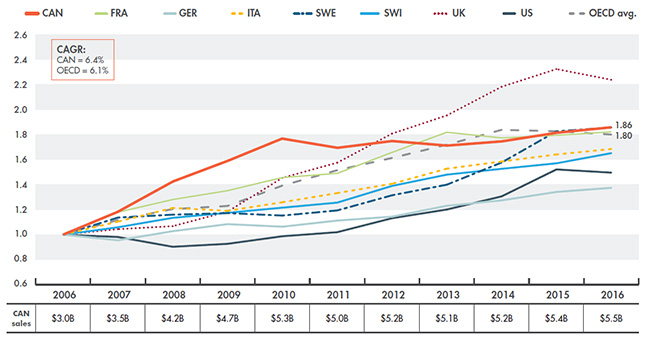
Figure description
This line graph gives the indexed rate of growth of generic retail sales for Canada and the seven PMPRB comparator countries, as well as the average for the Organisation for Economic Co-operation and Development countries. From 2006 to 2016, the compound annual growth rate for Canada was 6.4% and 6.1% for the Organisation for Economic Co-operation and Development countries.
blank
| Country |
2006 |
2007 |
2008 |
2009 |
2010 |
2011 |
2012 |
2013 |
2014 |
2015 |
2016 |
| Canada |
1.00 |
1.18 |
1.42 |
1.59 |
1.77 |
1.69 |
1.75 |
1.71 |
1.75 |
1.81 |
1.86 |
| France |
1.00 |
1.18 |
1.28 |
1.35 |
1.46 |
1.49 |
1.66 |
1.82 |
1.77 |
1.79 |
1.82 |
| Germany |
1.00 |
0.95 |
1.03 |
1.08 |
1.06 |
1.11 |
1.14 |
1.23 |
1.27 |
1.34 |
1.37 |
| Italy |
1.00 |
1.10 |
1.21 |
1.19 |
1.26 |
1.33 |
1.41 |
1.53 |
1.58 |
1.64 |
1.68 |
| Sweden |
1.00 |
1.14 |
1.16 |
1.17 |
1.15 |
1.19 |
1.31 |
1.40 |
1.58 |
1.83 |
1.86 |
| Switzerland |
1.00 |
1.06 |
1.13 |
1.17 |
1.22 |
1.26 |
1.39 |
1.48 |
1.53 |
1.57 |
1.65 |
| United States |
1.00 |
0.98 |
0.90 |
0.93 |
0.99 |
1.02 |
1.13 |
1.20 |
1.31 |
1.52 |
1.50 |
| United Kingdom |
1.00 |
1.04 |
1.07 |
1.18 |
1.45 |
1.58 |
1.81 |
1.95 |
2.18 |
2.32 |
2.24 |
| OECD average |
1.00 |
1.12 |
1.20 |
1.23 |
1.39 |
1.52 |
1.61 |
1.72 |
1.84 |
1.83 |
1.80 |
The table below the graph gives the total Canadian generic retail sales for each year: 2006: $3.0 billion; 2007: $3.5 billion; 2008: $4.2 billion; 2009: $4.7 billion; 2010: $5.3 billion; 2011: $5.0 billion; 2012: $5.2 billion; 2013: $5.1 billion; 2014: $5.2 billion; 2015: $5.4 billion; 2016: $5.5 billion.
Notes: Results reflect prescription drug sales in the national retail markets based on manufacturer ex-factory list prices.
The rates of growth are based on sales data reported in the local currency of each country; average OECD sales were determined by converting all currencies into US dollars.
Source: QuintilesIMS MIDAS™ database. All rights reserved.
From 2007 to 2011, the rates of growth in generic sales in Canada exceeded those of patented drugs, but with the introduction of generic pricing policies between 2010 and 2013, the pattern reversed, and the rate of change in generic sales dropped to a low of -5.1% in 2011. Since then, the growth in generic drug sales has bounced back, reaching 3.8% in 2015 followed by 2.1% in 2016, while still remaining lower than the increases in patented drug sales. Figure 1.2 compares the growth in Canadian sales for generic drugs with the growth for patented drugs over the last decade.
Figure 1.2 Rate of change in retail sales, generic versus patented drugs, Canada, 2006 to 2016
Click on image for larger view
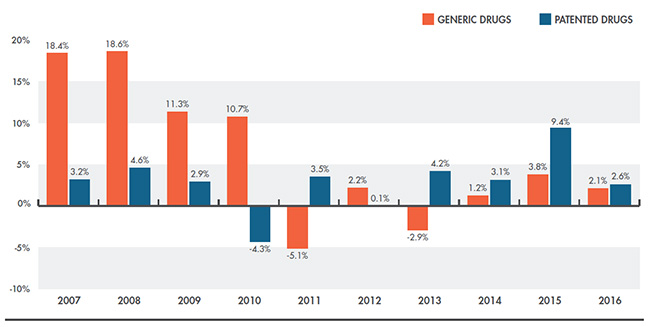
Figure description
This column graph compares the rate of change in retail sales of generic and patented drugs from 2006 to 2016.
blank
| Drug category |
2007 |
2008 |
2009 |
2010 |
2011 |
2012 |
2013 |
2014 |
2015 |
2016 |
| Generic |
18.4% |
18.6% |
11.3% |
10.7% |
-5.1% |
2.2% |
-2.9% |
1.2% |
3.8% |
2.1% |
| Patented |
3.2% |
4.6% |
2.9% |
-4.3% |
3.5% |
0.1% |
4.2% |
3.1% |
9.4% |
2.6% |
Note: Results reflect prescription drug sales in the national retail market based on manufacturer ex-factory list prices.
Source: For generic drugs: QuintilesIMS MIDAS™ database. All rights reserved.
For patented drugs: PMPRB Annual Report, 2016.
While there has been a steady increase in the generic share of units in the Canadian pharmaceutical market, the share of sales has remained somewhat stable. In fact, from 2010 to 2016 when the share of units underwent the greatest increase from 62% to 74%, the share of generic pharmaceutical sales declined from 31% to 28%. This reflects a relatively lower sales growth for generic products due to the provincial and pCPA policies, while the brand-name segment saw a relative expansion. Figure 1.3 illustrates the trends in the pharmaceutical market share of generic and brand-name products in Canada from 2006 to 2016 in terms of (a) units and (b) sales.
Figure 1.3 Generic share of the Canadian pharmaceutical retail market, 2006 to 2016
Click on image for larger view
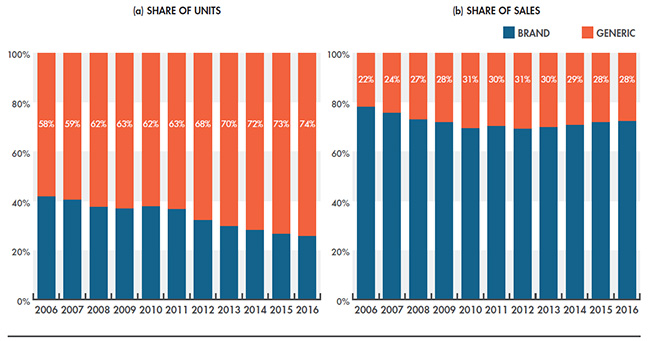
Figure description
These two side-by-side column graphs compare the generic and brand-name shares of the retail pharmaceutical market in Canada from 2006 to 2016. The first graph compares that share of units and the second compares the share of sales.
Share of Units
blank
| Drug category |
2006 |
2007 |
2008 |
2009 |
2010 |
2011 |
2012 |
2013 |
2014 |
2015 |
2016 |
| Brand-name |
42% |
41% |
38% |
37% |
38% |
37% |
32% |
30% |
28% |
27% |
26% |
| Generic |
58% |
59% |
62% |
63% |
62% |
63% |
68% |
70% |
72% |
73% |
74% |
Share of Sales
blank
| Drug category |
2006 |
2007 |
2008 |
2009 |
2010 |
2011 |
2012 |
2013 |
2014 |
2015 |
2016 |
| Brand-name |
78% |
76% |
73% |
72% |
69% |
70% |
69% |
70% |
71% |
72% |
72% |
| Generic |
22% |
24% |
27% |
28% |
31% |
30% |
31% |
30% |
29% |
28% |
28% |
Note: Results reflect prescription drug sales in the national retail market based on manufacturer ex-factory list prices.
Source: QuintilesIMS MIDAS™ database. All rights reserved.
The 74% generic market share in Canada in 2016 represents one of the highest rates of generic drug use among the OECD countries, ranking third after the US (82%) and Germany (76%). In terms of sales, the 28% market share in Canada was above the OECD median of 23%, higher than the other PMPRB7 countries with the exception of the UK at 38%. Figure 1.4 compares the market share of generic drugs in Canada with the other OECD countries in 2016.
Figure 1.4 Market shares of generic drugs, OECD, 2016
Click on image for larger view
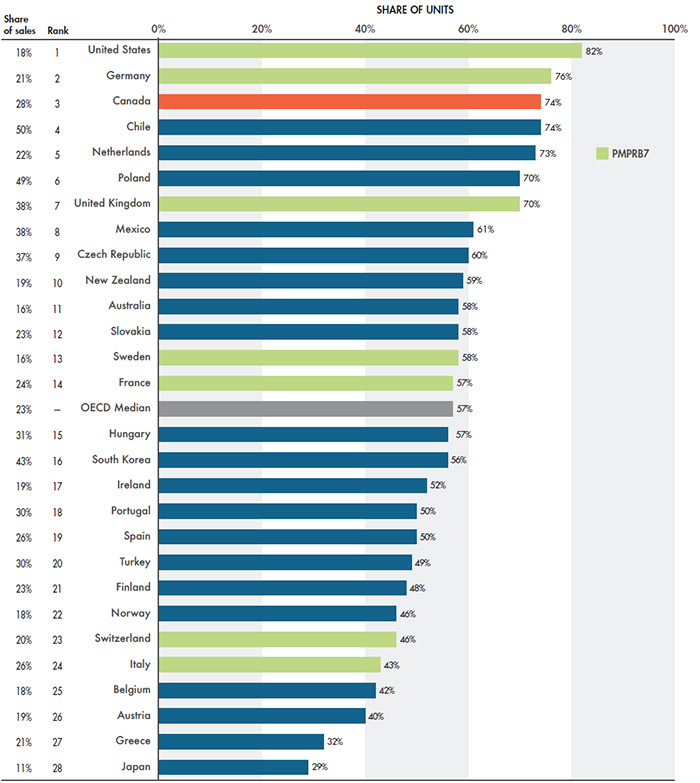
Figure description
This horizontal bar graph depicts the generic drug shares of the retail pharmaceutical market in 2016 for the Organisation for Economic Co-operation and Development countries. The bars represent the share of units for each country, while the share of sales is listed to the left.
blank
| Rank |
Country |
Generic share of sales |
Generic share of units |
| 1 |
United States |
18% |
82% |
| 2 |
Germany |
21% |
76% |
| 3 |
Canada |
28% |
74% |
| 4 |
Chile |
50% |
74% |
| 5 |
Netherlands |
22% |
73% |
| 6 |
Poland |
49% |
70% |
| 7 |
United Kingdom |
38% |
70% |
| 8 |
Mexico |
38% |
61% |
| 9 |
Czech Republic |
37% |
60% |
| 10 |
New Zealand |
19% |
59% |
| 11 |
Australia |
16% |
58% |
| 12 |
Slovakia |
23% |
58% |
| 13 |
Sweden |
16% |
58% |
| 14 |
France |
24% |
57% |
| ― |
OECD median |
23% |
57% |
| 15 |
Hungary |
31% |
57% |
| 16 |
South Korea |
43% |
56% |
| 17 |
Ireland |
19% |
52% |
| 18 |
Portugal |
30% |
50% |
| 19 |
Spain |
26% |
50% |
| 20 |
Turkey |
30% |
49% |
| 21 |
Finland |
23% |
48% |
| 22 |
Norway |
18% |
46% |
| 23 |
Switzerland |
20% |
46% |
| 24 |
Italy |
26% |
43% |
| 25 |
Belgium |
18% |
42% |
| 26 |
Austria |
19% |
40% |
| 27 |
Greece |
21% |
32% |
| 28 |
Japan |
11% |
29% |
Note: Results reflect prescription drug sales in the national retail market based on manufacturer ex-factory list prices reported in the local currency of each country; average OECD sales were determined by converting all currencies into US dollars.
Source: QuintilesIMS MIDAS™ database. All rights reserved.
Canadians spend a lot more on drugs than is spent on many other industrialized nations when measured both in terms of the drug expenditure share of the gross domestic product and in terms of drug spending per capita (PMPRB 2017b). Similar findings apply to generic drugs, with higher Canadian per capita spending compared to all other OECD countries except for the US.
While this report focuses on generic sales and prices in the national retail market, Figure 1.5 reports generic drug spending per capita in the combined retail and hospital market segments for the OECD countries. This allows for a more comprehensive view of Canada’s position within the broader global context. Per capita generic spending is expressed in (a) Canadian dollars and (b) US dollars at purchasing power parity (PPP). PPP measures the relative cost of living between countries, which is determined by pricing out a standard “basket” of goods and services at the prices prevailing in each country. Because PPPs are designed to represent relative costs of living, they offer a simple way to account for the differences in overall national price levels when comparing individual prices, incomes and other monetary values across countries.
Figure 1.5 Generic drug spending per capita, retail and hospital markets, OECD, 2016
Click on image for larger view
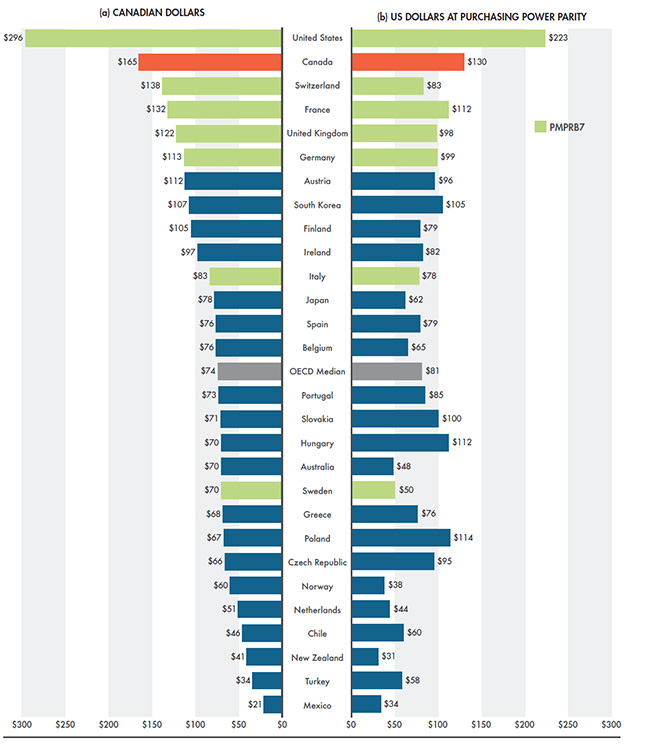
Figure description
These two side by side horizontal bar graphs give the per capita generic drug spending for the Organisation for Economic Co-operation and Development countries. The first graph gives the per capita combined retail and hospital sales for each country in Canadian dollars, while the second gives the combined retail and hospital sales in American dollars at purchasing power parity.
blank
| Country |
Per capita sales in Canadian dollars |
Per capita sales in American dollars at purchasing power parity |
| United States |
$296 |
$223 |
| Canada |
$165 |
$130 |
| Switzerland |
$138 |
$83 |
| France |
$132 |
$112 |
| United Kingdom |
$122 |
$98 |
| Germany |
$113 |
$99 |
| Austria |
$112 |
$96 |
| South Korea |
$107 |
$105 |
| Finland |
$105 |
$79 |
| Ireland |
$97 |
$82 |
| Italy |
$83 |
$78 |
| Japan |
$78 |
$62 |
| Spain |
$76 |
$79 |
| Belgium |
$76 |
$65 |
| OECD Median |
$74 |
$81 |
| Portugal |
$73 |
$85 |
| Slovakia |
$71 |
$100 |
| Hungary |
$70 |
$112 |
| Australia |
$70 |
$48 |
| Sweden |
$70 |
$50 |
| Greece |
$68 |
$76 |
| Poland |
$67 |
$114 |
| Czech Republic |
$66 |
$95 |
| Norway |
$60 |
$38 |
| Netherlands |
$51 |
$44 |
| Chile |
$46 |
$60 |
| New Zealand |
$41 |
$31 |
| Turkey |
$34 |
$58 |
| Mexico |
$21 |
$34 |
Note: Results reflect prescription drug sales in the combined national retail and hospital markets based on manufacturer ex-factory list prices.
Source: Sales data: QuintilesIMS MIDAS™ database. All rights reserved.
Purchasing power parity conversion: PMPRB.
2. International Price Comparisons
Average generic drug prices in Canada have been reduced to half of what they were a decade ago, with an even greater price drop for the most common drugs. While this decrease exceeded the overall price reductions in most PMPRB7 markets, the rate of decline has slowed in recent years.
Provincial and pCPA generic pricing policies coupled with a weakening Canadian dollar have gradually reduced the sizable gap between Canadian and foreign generic price levels over the past several years. Despite this, average prices in the PMPRB7 countries are still substantially less than Canadian levels, with the gap being slightly wider for the OECD countries. Canada has the seventh highest generic prices in the OECD, just below the US.
Trends in drug pricing
Through the implementation of provincial and pCPA pricing policies, generic prices in Canada began a period of rapid decline between Q3-2010 and Q3-2013, after which the rate of price decrease slowed, and by Q4-2016 generic prices were 49% lower than a decade before. At the same time, generic drug prices were also declining in other major pharmaceutical markets (PMPRB7) , which reduced the impact on Canada’s position relative to international prices. Prices in Germany fell by approximately the same amount as in Canada, while prices in Switzerland, Italy and France had much less pronounced decreases (up to 33%). In the US, the UK and Sweden, prices fluctuated, with relatively steep initial price drops followed by partial rebounds.
Figure 2.1 depicts the trends in generic prices in Canada and the PMPRB7 since 2007. The change in price is expressed as an index, with the Q4-2007 prices for each country set to a value of one based on local currency. The quarterly value for each country represents the cumulative change in the corresponding price since 2007.
While generic prices in Canada generally fell by 49%, the drop was even greater for the most common generic drugs, which were reduced to 18% of their reference name-brand prices, with a decrease of 67%.
Figure 2.1 Price indices for generic drugs, Canada and the PMPRB7*, Q4-2007 to Q4-2016
Click on image for larger view
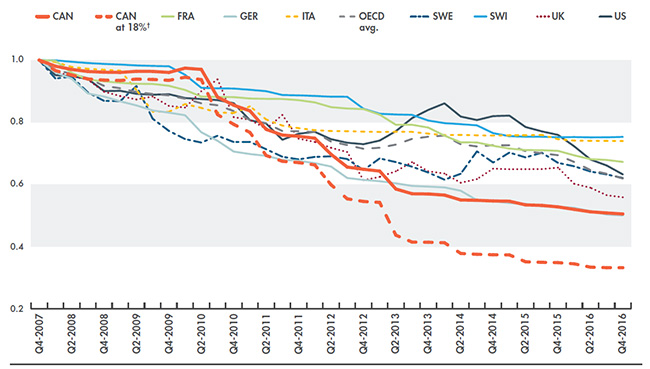
Figure description
This line graph gives price indices for Canada and the seven PMPRB comparator countries starting with the fourth quarter of 2007. Two sets of data are provided for Canada: one for all generic drugs and the other for the drugs at 18% of their brand-name price as of the end of 2016.
blank
| Quarter year |
Canada: all |
Canada: generic drugs at 18% |
France |
Germany |
Italy |
OECD
Average |
Sweden |
Switzerland |
United Kingdom |
United States |
| 2007: fourth quarter |
1.00 |
1.00 |
1.00 |
1.00 |
1.00 |
1.00 |
1.00 |
1.00 |
1.00 |
1.00 |
| 2008: first quarter |
0.98 |
0.97 |
1.00 |
0.96 |
0.99 |
0.97 |
0.94 |
1.00 |
0.96 |
0.95 |
| 2008: second quarter |
0.97 |
0.95 |
0.96 |
0.94 |
0.98 |
0.96 |
0.95 |
0.99 |
0.95 |
0.95 |
| 2008: third quarter |
0.96 |
0.94 |
0.94 |
0.89 |
0.97 |
0.94 |
0.90 |
0.99 |
0.94 |
0.94 |
| 2008: fourth quarter |
0.96 |
0.94 |
0.93 |
0.88 |
0.97 |
0.92 |
0.87 |
0.99 |
0.90 |
0.90 |
| 2009: first quarter |
0.96 |
0.93 |
0.93 |
0.87 |
0.97 |
0.91 |
0.87 |
0.99 |
0.88 |
0.90 |
| 2009: second quarter |
0.96 |
0.94 |
0.92 |
0.85 |
0.90 |
0.90 |
0.92 |
0.98 |
0.87 |
0.89 |
| 2009: third quarter |
0.96 |
0.94 |
0.92 |
0.84 |
0.83 |
0.89 |
0.81 |
0.98 |
0.88 |
0.89 |
| 2009: fourth quarter |
0.96 |
0.93 |
0.92 |
0.83 |
0.83 |
0.89 |
0.77 |
0.98 |
0.85 |
0.89 |
| 2010: first quarter |
0.97 |
0.94 |
0.90 |
0.82 |
0.86 |
0.88 |
0.75 |
0.95 |
0.85 |
0.88 |
| 2010: second quarter |
0.97 |
0.94 |
0.88 |
0.77 |
0.85 |
0.86 |
0.73 |
0.91 |
0.90 |
0.87 |
| 2010: third quarter |
0.88 |
0.82 |
0.88 |
0.74 |
0.83 |
0.85 |
0.76 |
0.91 |
0.94 |
0.87 |
| 2010: fourth quarter |
0.85 |
0.79 |
0.88 |
0.71 |
0.83 |
0.84 |
0.74 |
0.91 |
0.82 |
0.86 |
| 2011: first quarter |
0.84 |
0.77 |
0.88 |
0.70 |
0.85 |
0.81 |
0.74 |
0.90 |
0.81 |
0.81 |
| 2011: second quarter |
0.78 |
0.69 |
0.88 |
0.69 |
0.81 |
0.80 |
0.71 |
0.90 |
0.78 |
0.80 |
| 2011: third quarter |
0.76 |
0.67 |
0.87 |
0.68 |
0.79 |
0.77 |
0.69 |
0.89 |
0.82 |
0.74 |
| 2011: fourth quarter |
0.76 |
0.67 |
0.87 |
0.68 |
0.78 |
0.77 |
0.68 |
0.89 |
0.75 |
0.76 |
| 2012: first quarter |
0.75 |
0.66 |
0.86 |
0.67 |
0.77 |
0.77 |
0.69 |
0.88 |
0.74 |
0.77 |
| 2012: second quarter |
0.70 |
0.60 |
0.85 |
0.66 |
0.77 |
0.74 |
0.69 |
0.88 |
0.72 |
0.75 |
| 2012: third quarter |
0.66 |
0.55 |
0.84 |
0.62 |
0.77 |
0.73 |
0.68 |
0.88 |
0.70 |
0.73 |
| 2012: fourth quarter |
0.65 |
0.55 |
0.84 |
0.61 |
0.77 |
0.71 |
0.65 |
0.84 |
0.61 |
0.73 |
| 2013: first quarter |
0.64 |
0.54 |
0.82 |
0.61 |
0.77 |
0.72 |
0.68 |
0.83 |
0.62 |
0.74 |
| 2013: second quarter |
0.59 |
0.44 |
0.79 |
0.60 |
0.77 |
0.73 |
0.67 |
0.83 |
0.64 |
0.77 |
| 2013: third quarter |
0.57 |
0.41 |
0.79 |
0.60 |
0.77 |
0.75 |
0.66 |
0.82 |
0.67 |
0.81 |
| 2013: fourth quarter |
0.57 |
0.41 |
0.78 |
0.59 |
0.76 |
0.75 |
0.64 |
0.81 |
0.64 |
0.84 |
| 2014: first quarter |
0.57 |
0.41 |
0.76 |
0.59 |
0.76 |
0.76 |
0.62 |
0.80 |
0.64 |
0.86 |
| 2014: second quarter |
0.55 |
0.38 |
0.74 |
0.58 |
0.76 |
0.73 |
0.63 |
0.79 |
0.61 |
0.82 |
| 2014: third quarter |
0.55 |
0.38 |
0.74 |
0.55 |
0.76 |
0.72 |
0.71 |
0.79 |
0.62 |
0.81 |
| 2014: fourth quarter |
0.55 |
0.37 |
0.72 |
0.55 |
0.76 |
0.73 |
0.67 |
0.77 |
0.65 |
0.82 |
| 2015: first quarter |
0.55 |
0.37 |
0.72 |
0.54 |
0.76 |
0.73 |
0.70 |
0.76 |
0.65 |
0.82 |
| 2015: second quarter |
0.53 |
0.35 |
0.71 |
0.54 |
0.76 |
0.71 |
0.69 |
0.75 |
0.65 |
0.78 |
| 2015: third quarter |
0.53 |
0.35 |
0.71 |
0.53 |
0.76 |
0.70 |
0.70 |
0.75 |
0.65 |
0.77 |
| 2015: fourth quarter |
0.53 |
0.35 |
0.71 |
0.53 |
0.75 |
0.69 |
0.67 |
0.75 |
0.65 |
0.76 |
| 2016: first quarter |
0.52 |
0.34 |
0.69 |
0.53 |
0.74 |
0.67 |
0.66 |
0.75 |
0.60 |
0.72 |
| 2016: second quarter |
0.51 |
0.33 |
0.68 |
0.51 |
0.74 |
0.65 |
0.64 |
0.75 |
0.59 |
0.68 |
| 2016: third quarter |
0.51 |
0.33 |
0.68 |
0.50 |
0.74 |
0.63 |
0.63 |
0.75 |
0.57 |
0.66 |
| 2016: fourth quarter |
0.51 |
0.33 |
0.67 |
0.50 |
0.74 |
0.62 |
0.62 |
0.75 |
0.56 |
0.63 |
Note: Results are based on manufacturer ex-factory list prices in the national retail markets.
The price index for each country was based on local currency using country-specific sale weights for the drugs.
*France, Germany, Italy, Sweden, Switzerland, the United Kingdom and the United States.
†Includes eighteen of the most common generic drugs priced at 18% of their equivalent brand-name products through the efforts of the pCPA.
Source: QuintilesIMS MIDAS™ database, October–December 2007 to October–December 2016. All rights reserved.
The recent evolution in generic pricing in Canada can also be examined in terms of the change in generic-to-brand price ratios. Figure 2.2 reports average generic prices relative to their corresponding brand-name reference products from 2010 to 2016. The results depict the same trend, with relative generic prices rapidly decreasing between Q1-2010 and Q4-2012, followed by more stable price levels.
From Q1-2010 to Q4-2016, generic prices fell, on average, from 63% to 33% of their corresponding brand-name price levels, reflecting provincial and pCPA pricing policies. Note that these average results encompass generic drugs and prices in all three market segments, public, private and out-of-pocket, and include drugs that fall outside the generic pricing policies.
Figure 2.2 Average generic-to-brand price ratios, Canada, Q1-2010 to Q4-2016
Click on image for larger view
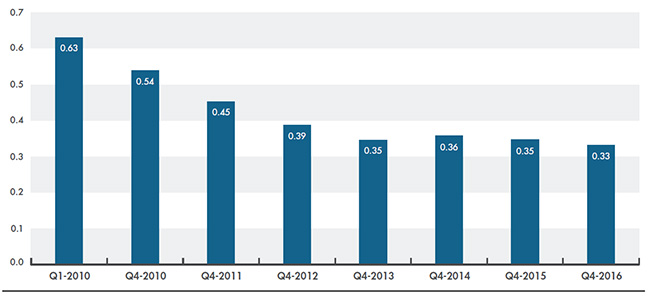
Figure description
This column graph gives the Canadian generic-to-brand price ratios from 2010 to 2016.
First quarter of 2010: 0.63; fourth quarter of 2010: 0.54; fourth quarter of 2011: 0.45; fourth quarter of 2012: 0.39; fourth quarter of 2013: 0.35; fourth quarter of 2014: 0.36; fourth quarter of 2015: 0.35; fourth quarter of 2016: 0.33.
Note: Results are based on manufacturer ex-factory list prices in the national retail market.
Source: QuintilesIMS MIDAS™ database, January–March 2010 to October–December 2016. All rights reserved.
Multilateral price comparisons
The international price comparisons reported in this section are expressed as foreign-to-Canadian generic price ratios where the average generic price level in Canada is set to one and the corresponding foreign prices are determined to be either higher (above) or lower (below) than this level. Multilateral price ratios compare the generic price levels in Canada with levels across all countries analyzed, while bilateral price ratios compare the generic price levels in Canada with those in each individual country.
For a more complete definition of the measures reported and an in-depth description of how the average foreign-to-Canadian price ratios are calculated, see the reference documents section of the Analytical Studies page on the PMPRB website.
The average price of generic drugs in Canada continues to be higher than in its comparator markets, although the gap between them has been gradually decreasing. In 2010, the average price in the PMPRB7 markets was 40% less than in Canada; this decreased to 11% in 2016. When median values are considered, there is an even greater gap between foreign and Canadian prices, as the results are no longer skewed by exceptionally high or low generic prices in select markets. In 2016, median foreign prices were 30% less than in Canada.
Figure 2.3 shows the trend in multilateral foreign-to-Canadian ratios for the PMPRB7 from Q4-2010 to Q4-2016. While the difference between average foreign and Canadian prices is decreasing, the rate of decrease has slowed over the past few years. The most significant reduction in the gap between foreign and Canadian prices took place between Q4-2012 and Q4-2013. Note that these results reflect not only the reductions in the Canadian prices of generic drugs, but also the fluctuations in currency exchange rates and the changes in generic prices observed in foreign markets as reported in Figure 2.1. These aspects are discussed further in the highlighted section: What is Driving the Change in Foreign-to-Canadian Price Ratios?
The table below Figure 2.3 reports the number of drugs included in the analysis, the corresponding Canadian generic sales ($million) and their respective share of total Canadian generic sales for the selected drugs in Q4-2016. For example, 364 drugs were used to calculate the mean and median foreign-to-Canadian price ratios. While these drugs accounted for a relatively small share (22.6%) of the number of generic drugs in Canada in 2016, they represented a relatively large share of sales: 59% of all generic drug sales in Canada.
Figure 2.3 Multilateral foreign-to-Canadian price ratios, PMPRB7* ‒ Generic drugs, Q4-2010 to Q4-2016
Click on image for larger view
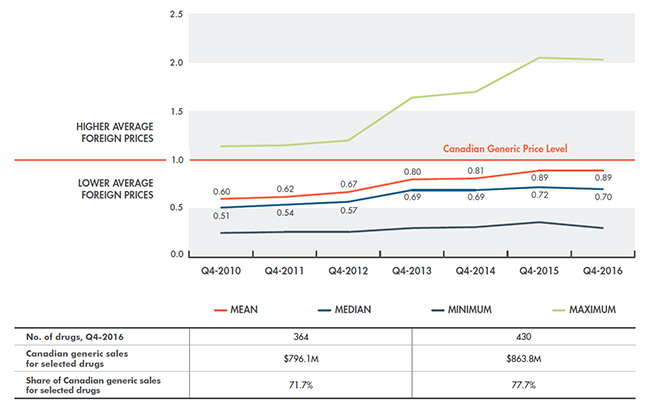
Figure description
This line graph gives the trend in multilateral foreign-to-Canadian price ratios for the seven PMPRB comparator countries from the fourth quarter of 2010 to the fourth quarter of 2016. The Canadian generic price level is set to one. Ratios greater than one indicate higher average foreign prices, while ratios less than one indicate lower foreign prices.
blank
| Quarter year |
Mean |
Median |
Minimum |
Maximum |
| 2010: fourth quarter |
0.60 |
0.51 |
0.25 |
1.14 |
| 2011: fourth quarter |
0.62 |
0.54 |
0.26 |
1.15 |
| 2012: fourth quarter |
0.67 |
0.57 |
0.26 |
1.20 |
| 2013: fourth quarter |
0.80 |
0.69 |
0.30 |
1.64 |
| 2014: fourth quarter |
0.81 |
0.69 |
0.31 |
1.70 |
| 2015: fourth quarter |
0.89 |
0.72 |
0.36 |
2.05 |
| 2016: fourth quarter |
0.89 |
0.70 |
0.30 |
2.03 |
The attached table gives information on the drugs used in the calculation of the price ratios for the fourth quarter of 2016.
blank
| Measured values |
Number of drugs |
Canadian generic sales for selected drugs in millions of dollars |
Share of Canadian generic sales for selected drugs |
| Mean and median |
364 |
$796.1 |
71.7% |
| Minimum and maximum |
430 |
$863.8 |
77.7% |
Note: Results are based on manufacturer ex-factory list prices in the national retail markets.
The analysis was restricted to generic drugs that had been on the market for at least one year. Minimum and maximum values were calculated for drugs with prices available in at least two foreign markets; mean and median values were calculated for drugs with prices available in at least three foreign markets.
*France, Germany, Italy, Sweden, Switzerland, the United Kingdom and the United States.
Source: QuintilesIMS MIDAS™ database, October–December 2010 to October–December 2016. All rights reserved.
What is Driving the Change in Foreign-to-Canadian Price Ratios?
Changes in foreign-to-Canadian price ratios over time are driven by four main factors: price changes in Canada; price changes in foreign markets; changes in currency exchanges rates; and changes in the generic mix (that is, changes in the mix and the weights of generic drugs being compared). To examine the four factors in more detail, each effect was isolated by measuring its change between the first time period and the second while keeping all other factors constant.
Over the past four years, the gap between foreign and Canadian generic prices decreased from 33% in 2012 to 11% in 2016. This 22% change mainly resulted from a combination of three factors: (i) declining generic prices in Canada (15%); (ii) more favorable foreign exchange rates due to the weakening Canadian dollar (8%); and (iii) declining prices in foreign markets which widened the gap between Canadian and foreign prices (-5%). Other minor factors, such as the change in the expenditure weights of drugs included in the calculations and the cross effect resulting from the interaction between drivers, also contributed to the overall change.
When comparing Canadian prices to the average for the OECD, the gap is slightly wider. In 2016, mean OECD prices were 12% lower than Canadian prices, compared to 11% for the PMPRB7, and median OECD prices were 33% less (Figure 2.4).
Figure 2.4 Multilateral foreign-to-Canadian price ratios, PMPRB7* and OECD ‒ Generic drugs, Q4-2016
Click on image for larger view

Figure description
This column graph compares the multilateral foreign-to-Canadian price ratios for the seven PMPRB comparator countries and the Organisation for Economic Co-operation and Development countries for the fourth quarter of 2016. The Canadian generic price level is set to one. Ratios greater than one indicate higher average foreign prices, while ratios less than one indicate lower foreign prices.
blank
| Countries |
Minimum |
Mean |
Median |
Maximum |
| PMPRB7 |
0.30 |
0.89 |
0.70 |
2.03 |
| OECD |
0.26 |
0.88 |
0.67 |
2.69 |
The attached table gives information on the drugs used in the calculation of the price ratios.
blank
| Measured values |
Number of drugs included in the calculation |
Canadian generic sales for selected drugs in millions of dollars |
Share of Canadian generic sales for selected drugs |
| PMPRB7 mean and median |
364 |
796.1 |
71.7% |
| PMPRB7 minimum and maximum |
430 |
863.8 |
77.7% |
| OECD mean and median |
489 |
980.5 |
88.2% |
| OECD minimum and maximum |
528 |
1,029.5 |
92.7% |
Note: Results are based on manufacturer ex-factory list prices in the national retail markets.
The analysis was restricted to generic drugs that had been on the market for at least one year. Minimum and maximum values were calculated for drugs with prices available in at least two foreign markets; mean and median values were calculated for drugs with prices available in at least three foreign markets.
*France, Germany, Italy, Sweden, Switzerland, the United Kingdom and the United States.
Source: QuintilesIMS MIDAS™ database, October–December 2016. All rights reserved.
Appendix A provides foreign-to-Canadian multilateral price ratios for the 25 top-selling generic drugs included in this analysis.
Bilateral price comparisons
The recent gains in bringing Canadian prices in line with international levels are also observed in the bilateral comparisons with individual countries. For example, generic drug prices in France, Germany and Italy, which were generally 50% lower than in Canada in 2010, were approximately 25% lower in 2016. Average Swiss and American prices, which were lower than the Canadian levels in 2010, were higher in 2016. Canada demonstrated only a slight improvement when compared to countries with the lowest relative generic prices in 2010, e.g. the Netherlands and New Zealand. Contrary to the trend for the other countries, prices in Australia fell considerably relative to Canadian prices between 2010 and 2016. These varying degrees of change in the bilateral foreign-to-Canadian price ratios reflect the evolution of generic prices in the respective foreign markets, as well as varying exchange rates.
Figure 2.5 gives the average bilateral foreign-to-Canadian price ratios for the PMPRB7 and other select countries in Q4-2010 and Q4-2016.
Figure 2.5 Bilateral foreign-to-Canadian price ratios, PMPRB7* and other select countries ‒ Generic drugs, Q4-2010 versus Q4-2016
Click on image for larger view
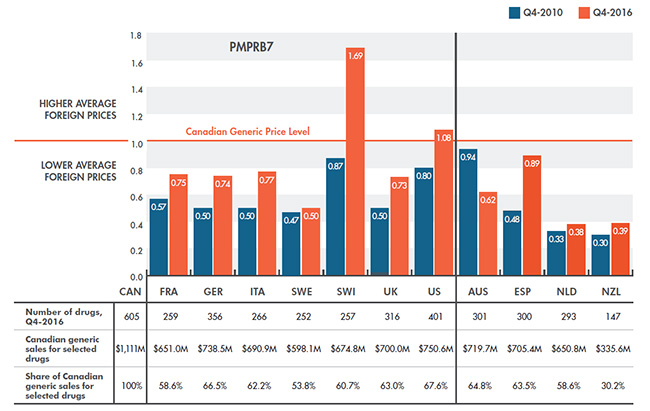
Figure description
This column graph compares the bilateral foreign-to-Canadian price ratios for select countries in the fourth quarter of 2010 and the fourth quarter of 2016. The Canadian generic price level is set to one. Ratios greater than one indicate higher average foreign prices, while ratios less than one indicate lower foreign prices.
blank
| Country |
Foreign-to-Canadian price ratio for the fourth quarter of 2010 |
Foreign-to-Canadian price ratio for the fourth quarter of 2016 |
| France |
0.57 |
0.75 |
| Germany |
0.50 |
0.74 |
| Italy |
0.50 |
0.77 |
| Sweden |
0.47 |
0.50 |
| Switzerland |
0.87 |
1.69 |
| United Kingdom |
0.50 |
0.73 |
| United States |
0.80 |
1.08 |
| Australia |
0.94 |
0.62 |
| Spain |
0.48 |
0.89 |
| Netherlands |
0.33 |
0.38 |
| New Zealand |
0.30 |
0.39 |
The attached table gives information on the drugs used in the calculation of the price ratios for the fourth quarter of 2016:
blank
| Country |
Number of drugs |
Canadian generic sales for selected drugs in millions of dollars |
Share of Canadian generic sales for selected drugs |
| Canada |
605 |
1111.1 |
100.0% |
| France |
259 |
651.0 |
58.6% |
| Germany |
356 |
738.5 |
66.5% |
| Italy |
266 |
690.9 |
62.2% |
| Sweden |
252 |
598.1 |
53.8% |
| Switzerland |
257 |
674.8 |
60.7% |
| United Kingdom |
316 |
700.0 |
63.0% |
| United States |
401 |
750.6 |
67.6% |
| Australia |
301 |
719.7 |
64.8% |
| Spain |
300 |
705.4 |
63.5% |
| Netherlands |
293 |
650.8 |
58.6% |
| New Zealand |
147 |
335.6 |
30.2% |
Note: Results are based on manufacturer ex-factory list prices in the national retail markets.
The analysis was restricted to generic drugs that had been on the market for at least one year.
*France, Germany, Italy, Sweden, Switzerland, the United Kingdom and the United States.
Source: QuintilesIMS MIDAS™ database, October–December 2010 and October–December 2016. All rights reserved.
Caution should be used when interpreting the results for countries with a low drug match. For example, bilateral price comparisons with New Zealand only compare 147 out of a possible 605 drugs, representing 30.2% of the sales analyzed. A low drug match could indicate that there is limited generic availability in the respective foreign market or that there are differences in the available strengths and forms between Canada and the foreign market.
In a country-to-country comparison, the prices of generic drugs in Canada in Q4-2016 were the seventh highest in the OECD, slightly less than the US and significantly higher than most of its European comparators.
Figure 2.6 gives the bilateral foreign-to-Canadian price ratios for the OECD countries. Prices in Mexico, Chile, Switzerland, South Korea and Japan were much higher than in Canada, with foreign-to-Canadian price ratios ranging from 1.47 to 2.25. However, generic prices in most other countries were lower, with some key comparators, such as Australia, Sweden and the Netherlands having prices 38%, 50% and 62% lower than in Canada, respectively.
The drug match between Canada and other countries may have been relatively low in some cases and this may have influenced individual bilateral results, however, the overall trend is clear.
Figure 2.6 Bilateral foreign-to-Canadian price ratios, OECD – Generic drugs, Q4-2016
Click on image for larger view
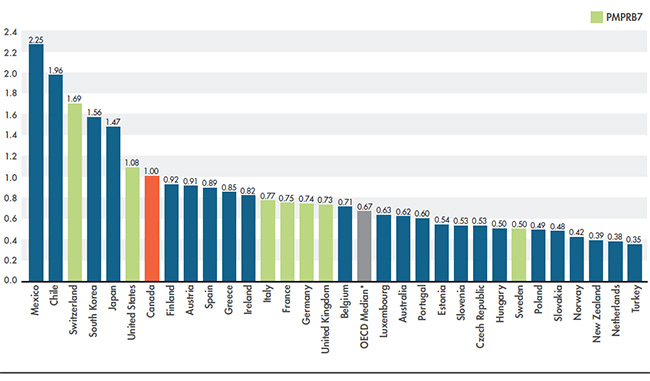
Figure description
This column graph compares the bilateral foreign-to-Canadian price ratios for Organisation for Economic Co-operation and Development countries for the fourth quarter of 2016. The Canadian generic price level is set to one. Ratios greater than one indicate higher average foreign prices, while ratios less than one indicate lower foreign prices.
blank
| Country |
Foreign-to-Canadian price ratio |
| Mexico |
2.25 |
| Chile |
1.96 |
| Switzerland |
1.69 |
| South Korea |
1.56 |
| Japan |
1.47 |
| United States |
1.08 |
| Finland |
0.92 |
| Austria |
0.91 |
| Spain |
0.89 |
| Greece |
0.85 |
| Ireland |
0.82 |
| Italy |
0.77 |
| France |
0.75 |
| Germany |
0.74 |
| United Kingdom |
0.73 |
| Belgium |
0.71 |
| OECD Median* |
0.67 |
| Luxembourg |
0.63 |
| Australia |
0.62 |
| Portugal |
0.60 |
| Estonia |
0.54 |
| Slovenia |
0.53 |
| Czech Republic |
0.53 |
| Hungary |
0.50 |
| Sweden |
0.50 |
| Poland |
0.49 |
| Slovakia |
0.48 |
| Norway |
0.42 |
| New Zealand |
0.39 |
| Netherlands |
0.38 |
| Turkey |
0.35 |
Note: Results are based on manufacturer ex-factory list prices in the national retail markets.
The analysis was restricted to generic drugs that had been on the market for at least one year.
*The OECD median does not represent the median result for the individual countries reported in this graph; it is calculated at the drug level for drugs with prices available in at least three foreign markets.
Source: QuintilesIMS MIDAS™ database, October–December 2016. All rights reserved.
3. International Price Comparisons by Market Segment
While average generic prices for the PMPRB7 were generally 11% lower than Canadian prices in 2016, the difference between them varied appreciably depending on the market segment considered. For example, the gap between foreign and Canadian prices was less pronounced for smaller markets with lower sales.
Although generic pricing policies have achieved substantial discounts and savings for Canadians, the gap between Canadian and foreign prices for drugs subject to the 18% rule was even greater than for generic drugs in general. Price reductions for drugs subject to the Tiered Pricing Framework are similar to those for generic drugs in general, showing only modest additional gains in Canada’s relative position internationally.
An analysis of market segments gives additional insight into the gaps between Canadian and international generic prices. Contrary to expectations, as the market size increases, the price differential between average Canadian and foreign prices grows larger, suggesting that Canada is not benefitting from the same economy of scale as its comparators.
For smaller generic markets with sales in Canada of $1 to $5 million, Canadian and foreign prices in Q4-2016 were somewhat similar, with a 9% higher mean and a 14% lower median foreign price (Figure 3.1). In contrast, for generic markets with Canadian sales greater than $10 million, mean foreign prices were approximately 17% lower than corresponding Canadian prices and median foreign prices were 36% lower.
Despite this discrepancy, over the last two years, the gap between mean Canadian and foreign prices has decreased for all market sizes (Figure 3.2). The greatest relative gain has been in the smaller generic markets.
Figure 3.1 Multilateral foreign-to-Canadian price ratios, PMPRB7* — Generic drugs by market size, Q4-2016
Click on image for larger view
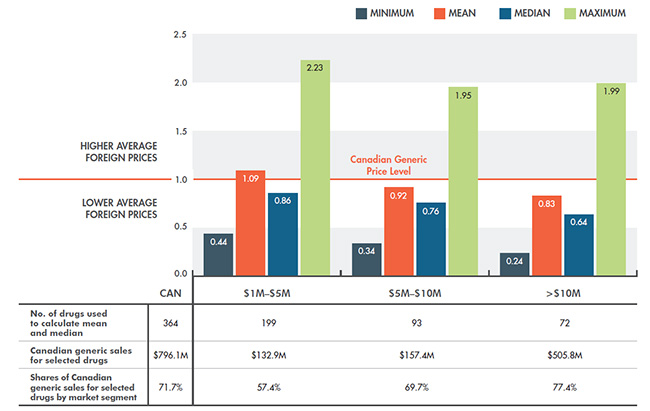
Figure description
This column graph compares the multilateral foreign-to-Canadian price ratios for the seven PMPRB comparator countries in the fourth quarter of 2016 by market size: generic drugs with fourth quarter sales in 2016 of 1 to 5 million dollars; 5 to 10 million dollars; and over 10 million dollars. The Canadian generic price level is set to one. Ratios greater than one indicate higher average foreign prices, while ratios less than one indicate lower foreign prices.
blank
| Market size by drug sales |
Minimum |
Mean |
Median |
Maximum |
| 1 to 5 million dollars |
0.44 |
1.09 |
0.86 |
2.23 |
| 5 to 10 million dollars |
0.34 |
0.92 |
0.76 |
1.95 |
| Over 10 million dollars |
0.24 |
0.83 |
0.64 |
1.99 |
The attached table gives information on the drugs used in the calculation of the mean and median price ratios:
blank
|
Drugs with sales of 1 to 5 million dollars |
Drugs with sales of 5 to 10 million dollars |
Drugs with sales of over 10 million dollars |
Total |
| Number of drugs |
199 |
93 |
72 |
364 |
| Canadian generic sales for selected drugs (in millions of dollars) |
$132.9 |
$157.4 |
$505.8 |
$796.1 |
| Shares of Canadian generic sales for selected drugs by market segment |
57.4% |
69.7% |
77.4% |
71.7% |
Note: Results are based on manufacturer ex-factory list prices in the national retail markets.
Market size was based on annual Canadian sales. The analysis was restricted to generic drugs that had been on the market for at least one year.
*France, Germany, Italy, Sweden, Switzerland, the United Kingdom and the United States.
Source: QuintilesIMS MIDAS™ database, October–December 2016. All rights reserved.
Figure 3.2 Multilateral foreign-to-Canadian price ratios, PMPRB7* — Generic drugs by market size, Q4-2014 and Q4-2016
Click on image for larger view
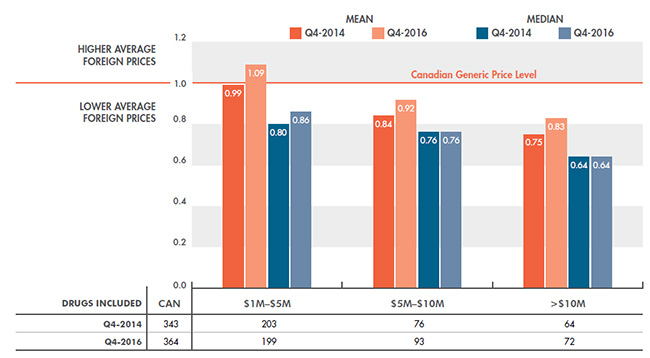
Figure description
This column graph compares the mean and median foreign-to-Canadian price ratios for the seven PMPRB comparator countries for the fourth quarter of 2014 to the fourth quarter of 2016 by market size: generic drugs with fourth quarter sales in 2016 of 1 to 5 million dollars; 5 to 10 million dollars; and over 10 million dollars. The Canadian generic price level is set to one. Ratios greater than one indicate higher average foreign prices, while ratios less than one indicate lower foreign prices.
blank
| Market size by drug sales |
1 to 5 million dollars |
5 to 10 million dollars |
Over 10 million dollars |
| Mean foreign-to-Canadian price ratio for the fourth quarter of 2014 |
0.99 |
0.84 |
0.75 |
| Mean foreign-to-Canadian price ratio for the fourth quarter of 2016 |
1.09 |
0.92 |
0.83 |
| Median foreign-to-Canadian price ratio for the fourth quarter of 2014 |
0.80 |
0.76 |
0.64 |
| Median foreign-to-Canadian price ratio for the fourth quarter of 2016 |
0.86 |
0.76 |
0.64 |
The attached table gives the number of drugs included in the calculation of the mean and median price ratios:
blank
| Quarter |
Drugs with sales of 1 to 5 million dollars |
Drugs with sales of 5 to 10 million dollars |
Drugs with sales of over 10 million dollars |
Total |
| 2014: fourth quarter |
203 |
76 |
64 |
343 |
| 2016: fourth quarter |
199 |
93 |
72 |
364 |
Note: Results are based on manufacturer ex-factory list prices in the national retail markets.
Market size was based on annual Canadian sales. The analysis was restricted to generic drugs that had been on the market for at least one year.
*France, Germany, Italy, Sweden, Switzerland, the United Kingdom and the United States.
Source: QuintilesIMS MIDAS™ database, October–December 2014 and October–December 2016. All rights reserved.
Figure 3.3 examines the foreign-to-Canadian price differentials for the market segments targeted by pan-Canadian Pharmaceutical Alliance (pCPA) policies: drugs under the 18% rule and those that have been subject to the Tiered Pricing Framework (TPF).
pCPA Initiatives
Provincial, territorial and federal governments work together through the pCPA to develop collaborative policies related to generic drug prices for their publicly funded drug programs. As of April 1, 2016, the prices of 18 commonly used generic drugs were reduced to 18% of their brand-name reference price, with the prices of six of these drugs further reduced to 15% as of April 1, 2017, as part of a one-year bridging arrangement. In January 2018, it was announced that as of April 1, 2018, the price of nearly 70 of the most commonly prescribed generic drugs in Canada will undergo a further reduction of 25% – 40%, resulting in overall discounts of up to 90% off the price of their brand-name equivalents.
In addition, in 2014 the pCPA introduced a pan-Canadian Tiered Pricing Framework that that sets the prices of new generic products based on the number of products available in the Canadian market. For example, a single-source generic is set at 85% of its brand reference price if a Product Listing Agreement (PLA) does not exist for the brand product and 75% if there is a PLA; generics with two sources are set at 50% of their reference brand product; and generics with three or more sources at 25% for oral solids and 35% for non-oral solids.
For an overview of the provincial generic pricing initiatives implemented since 2010 and the pCPA initiatives, see the reference documents section of the Analytical Studies webpage on the PMPRB website. Note that initiatives implemented after the last quarter of 2016 are not captured in the results of this report.
From 2012 to 2016, the gap between Canadian and foreign prices was reduced for all generics: mean foreign prices, which were 33% less in 2012, were 11% less in 2016; relative median prices also improved from 43% lower in 2012 to 30% in 2016. As shown in Figure 3.3, the relative prices for drugs subject to the TPF showed a similar improvement, with a gap of 13% between mean Canadian and foreign prices in Q4-2016 and 28% for median prices. For the drugs at 18%, the differences between their foreign and Canadian prices were slightly more pronounced, with mean foreign price levels 14% lower than in Canada and median levels 34% lower in Q4-2016.
Figure 3.3 Multilateral foreign-to-Canadian price ratios, PMPRB7* — Generic drugs by market segment, Q4-2012 and Q4-2016
Click on image for larger view
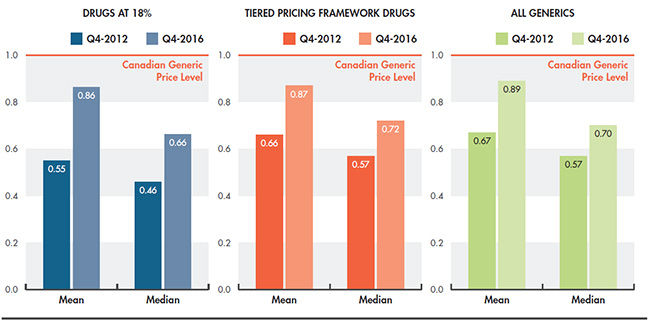
Figure description
These three column graphs compare the mean and median foreign-to-Canadian price ratios for the seven PMPRB comparator countries for the fourth quarter of 2012 to the fourth quarter of 2016. The first graph considers the multilateral price ratios for drugs at 18%; the second considers Tiered Pricing Framework drugs; and the third considers all generics. The Canadian generic price level is set to one. Ratios greater than one indicate higher average foreign prices, while ratios less than one indicate lower foreign prices.
blank
|
Mean: All generics |
Mean: Drugs at 18% |
Mean: Tiered Pricing Framework drugs |
Median: All generics |
Median: Drugs at 18% |
Median: Tiered Pricing Framework drugs |
| 2012: fourth quarter |
0.67 |
0.55 |
0.66 |
0.57 |
0.46 |
0.57 |
| 2016: fourth quarter |
0.89 |
0.86 |
0.87 |
0.70 |
0.66 |
0.72 |
Note: Results are based on manufacturer ex-factory list prices in the national retail markets.
Market size was based on annual Canadian sales. The analysis was restricted to generic drugs that had been on the market for at least one year.
*France, Germany, Italy, Sweden, Switzerland, the United Kingdom and the United States.
Source: QuintilesIMS MIDAS™ database, October–December 2012 and October–December 2016. All rights reserved.
The list of the Tiered Pricing Framework drugs was provided for this analysis by the jurisdictions participating in the NPDUIS initiative.
Figures 3.4 and 3.5 depict the price trends for TPF drugs and drugs at 18% in Canada and the PMPRB7 from 2007 to 2016. The change in price is expressed as an index, with the Q4-2007 price for each country set to a value of one based on local currency. The quarterly value for each country represents the cumulative change in the corresponding price since 2007.
In Canada, the price of drugs subject to the TPF regulations followed the same pattern of decline as for generic drugs in general, falling by approximately 46% between Q4-2007 and Q4-2016. The relative reduction in Canadian prices was among the greatest in the PMPRB7, similar to the decrease in Germany, the UK and the US. Prices in Italy and Switzerland showed the least change with a relative decrease of approximately 28%.
Figure 3.4 Price indices, generic drugs subject to the Tiered Pricing Framework, Canada and the PMPRB7*, Q4-2007 to Q4-2016
Click on image for larger view
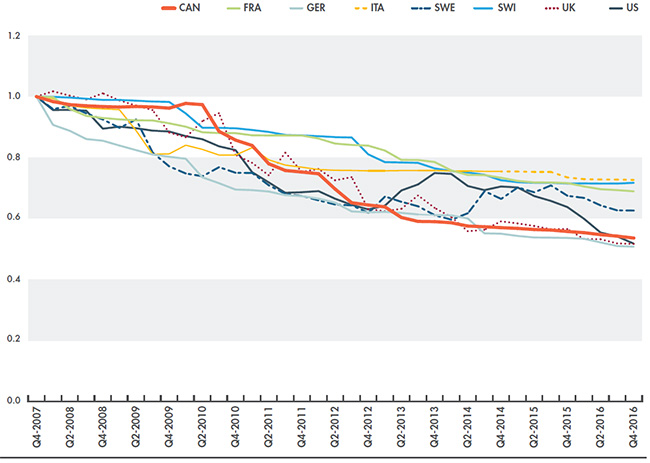
Figure description
This line graph depicts the price indices for Tiered Pricing Framework drugs for Canada and the seven PMPRB comparator countries starting with the fourth quarter of 2007.
blank
| Quarter year |
Canada |
France |
Germany |
Italy |
Sweden |
Switzerland |
United Kingdom |
United States |
| 2007: fourth quarter |
1.00 |
1.00 |
1.00 |
1.00 |
1.00 |
1.00 |
1.00 |
1.00 |
| 2008: first quarter |
0.98 |
1.00 |
0.91 |
0.99 |
0.96 |
1.00 |
1.02 |
0.96 |
| 2008: second quarter |
0.97 |
0.96 |
0.89 |
0.97 |
0.97 |
1.00 |
1.00 |
0.96 |
| 2008: third quarter |
0.97 |
0.94 |
0.86 |
0.96 |
0.94 |
0.99 |
0.99 |
0.95 |
| 2008: fourth quarter |
0.97 |
0.93 |
0.86 |
0.96 |
0.92 |
0.99 |
1.01 |
0.89 |
| 2009: first quarter |
0.97 |
0.93 |
0.84 |
0.96 |
0.90 |
0.99 |
0.99 |
0.90 |
| 2009: second quarter |
0.97 |
0.92 |
0.82 |
0.89 |
0.93 |
0.99 |
0.97 |
0.90 |
| 2009: third quarter |
0.97 |
0.92 |
0.81 |
0.81 |
0.82 |
0.98 |
0.96 |
0.89 |
| 2009: fourth quarter |
0.96 |
0.91 |
0.80 |
0.81 |
0.77 |
0.98 |
0.88 |
0.89 |
| 2010: first quarter |
0.98 |
0.90 |
0.80 |
0.84 |
0.75 |
0.94 |
0.87 |
0.87 |
| 2010: second quarter |
0.97 |
0.88 |
0.74 |
0.83 |
0.74 |
0.90 |
0.92 |
0.86 |
| 2010: third quarter |
0.89 |
0.88 |
0.72 |
0.81 |
0.77 |
0.90 |
0.95 |
0.84 |
| 2010: fourth quarter |
0.86 |
0.88 |
0.70 |
0.81 |
0.75 |
0.90 |
0.81 |
0.82 |
| 2011: first quarter |
0.84 |
0.87 |
0.69 |
0.83 |
0.75 |
0.89 |
0.78 |
0.75 |
| 2011: second quarter |
0.78 |
0.87 |
0.69 |
0.79 |
0.71 |
0.88 |
0.74 |
0.72 |
| 2011: third quarter |
0.76 |
0.87 |
0.68 |
0.78 |
0.68 |
0.87 |
0.82 |
0.68 |
| 2011: fourth quarter |
0.75 |
0.87 |
0.67 |
0.77 |
0.67 |
0.87 |
0.75 |
0.69 |
| 2012: first quarter |
0.75 |
0.86 |
0.67 |
0.76 |
0.66 |
0.87 |
0.76 |
0.69 |
| 2012: second quarter |
0.70 |
0.85 |
0.65 |
0.76 |
0.65 |
0.87 |
0.73 |
0.67 |
| 2012: third quarter |
0.65 |
0.84 |
0.62 |
0.76 |
0.64 |
0.87 |
0.74 |
0.65 |
| 2012: fourth quarter |
0.64 |
0.84 |
0.62 |
0.76 |
0.62 |
0.81 |
0.63 |
0.63 |
| 2013: first quarter |
0.64 |
0.82 |
0.62 |
0.76 |
0.67 |
0.79 |
0.62 |
0.64 |
| 2013: second quarter |
0.60 |
0.79 |
0.62 |
0.76 |
0.65 |
0.78 |
0.63 |
0.69 |
| 2013: third quarter |
0.59 |
0.79 |
0.61 |
0.76 |
0.64 |
0.78 |
0.68 |
0.71 |
| 2013: fourth quarter |
0.59 |
0.79 |
0.61 |
0.76 |
0.61 |
0.76 |
0.64 |
0.75 |
| 2014: first quarter |
0.59 |
0.76 |
0.61 |
0.76 |
0.60 |
0.76 |
0.61 |
0.75 |
| 2014: second quarter |
0.58 |
0.74 |
0.60 |
0.76 |
0.62 |
0.75 |
0.56 |
0.71 |
| 2014: third quarter |
0.57 |
0.74 |
0.55 |
0.75 |
0.69 |
0.74 |
0.56 |
0.69 |
| 2014: fourth quarter |
0.57 |
0.73 |
0.55 |
0.75 |
0.66 |
0.73 |
0.59 |
0.71 |
| 2015: first quarter |
0.57 |
0.72 |
0.54 |
0.75 |
0.70 |
0.72 |
0.58 |
0.70 |
| 2015: second quarter |
0.56 |
0.72 |
0.54 |
0.75 |
0.69 |
0.72 |
0.58 |
0.67 |
| 2015: third quarter |
0.56 |
0.72 |
0.54 |
0.75 |
0.71 |
0.72 |
0.57 |
0.66 |
| 2015: fourth quarter |
0.56 |
0.72 |
0.54 |
0.73 |
0.67 |
0.71 |
0.57 |
0.64 |
| 2016: first quarter |
0.55 |
0.71 |
0.53 |
0.73 |
0.67 |
0.72 |
0.53 |
0.60 |
| 2016: second quarter |
0.55 |
0.70 |
0.52 |
0.73 |
0.64 |
0.71 |
0.53 |
0.55 |
| 2016: third quarter |
0.54 |
0.69 |
0.51 |
0.73 |
0.63 |
0.71 |
0.52 |
0.54 |
| 2016: fourth quarter |
0.54 |
0.69 |
0.51 |
0.73 |
0.63 |
0.72 |
0.52 |
0.52 |
Note: Results are based on manufacturer ex-factory list prices in the national retail markets.
The price index for each country was based on local currency using country-specific sale weights for the drugs.
*France, Germany, Italy, Sweden, Switzerland, the United Kingdom and the United States.
Source: QuintilesIMS MIDAS™ database, October–December 2007 to October–December 2016. All rights reserved.
In contrast to the results for the TPF drugs, the prices of drugs subject to the 18% rule fell by a substantial 67%, a rate higher than for generic drugs in general. This was similar to the price drop in Germany, surpassing the other PMPRB7 countries except for the US, whose prices fell by an extraordinary 88% for this market segment.
As Canadian prices were much higher to begin with, this significant drop was still not enough to bring the price of these common generics in line with international levels.
The next section explores the cost implications of foreign-to-Canadian price differentials for the public drug plans.
Figure 3.5 Price indices, generic drugs subject to 18% rule, Canada and the PMPRB7*, Q4-2007 to Q4-2016
Click on image for larger view
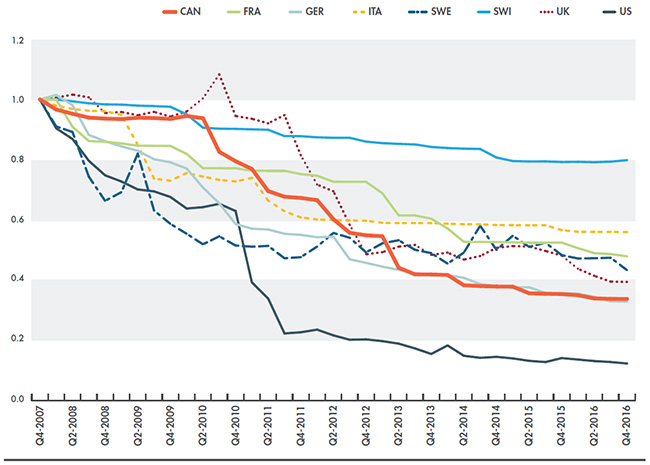
Figure description
This line graph depicts the price indices for drugs at 18% for Canada and the seven PMPRB comparator countries starting with the fourth quarter in 2007.
blank
|
Canada |
France |
Germany |
Italy |
Sweden |
Switzerland |
United Kingdom |
United States |
| 2007: fourth quarter |
1.00 |
1.00 |
1.00 |
1.00 |
1.00 |
1.00 |
1.00 |
1.00 |
| 2008: first quarter |
0.98 |
1.00 |
0.86 |
1.00 |
0.92 |
1.00 |
1.01 |
0.97 |
| 2008: second quarter |
0.97 |
0.97 |
0.84 |
0.97 |
0.93 |
0.99 |
0.99 |
0.98 |
| 2008: third quarter |
0.96 |
0.95 |
0.82 |
0.96 |
0.88 |
0.99 |
0.98 |
0.98 |
| 2008: fourth quarter |
0.96 |
0.94 |
0.81 |
0.96 |
0.86 |
0.99 |
0.91 |
0.88 |
| 2009: first quarter |
0.96 |
0.94 |
0.80 |
0.95 |
0.83 |
0.99 |
0.91 |
0.88 |
| 2009: second quarter |
0.97 |
0.94 |
0.78 |
0.87 |
0.83 |
0.99 |
0.89 |
0.88 |
| 2009: third quarter |
0.96 |
0.94 |
0.77 |
0.78 |
0.73 |
0.99 |
0.88 |
0.87 |
| 2009: fourth quarter |
0.96 |
0.93 |
0.76 |
0.78 |
0.66 |
0.98 |
0.81 |
0.85 |
| 2010: first quarter |
0.98 |
0.92 |
0.75 |
0.81 |
0.62 |
0.93 |
0.79 |
0.83 |
| 2010: second quarter |
0.97 |
0.90 |
0.67 |
0.80 |
0.60 |
0.88 |
0.83 |
0.83 |
| 2010: third quarter |
0.88 |
0.90 |
0.65 |
0.78 |
0.61 |
0.87 |
0.84 |
0.79 |
| 2010: fourth quarter |
0.86 |
0.90 |
0.63 |
0.77 |
0.58 |
0.87 |
0.74 |
0.78 |
| 2011: first quarter |
0.83 |
0.88 |
0.63 |
0.80 |
0.59 |
0.87 |
0.70 |
0.68 |
| 2011: second quarter |
0.77 |
0.88 |
0.63 |
0.75 |
0.55 |
0.86 |
0.67 |
0.64 |
| 2011: third quarter |
0.75 |
0.88 |
0.62 |
0.73 |
0.53 |
0.85 |
0.69 |
0.60 |
| 2011: fourth quarter |
0.75 |
0.88 |
0.61 |
0.73 |
0.52 |
0.85 |
0.65 |
0.60 |
| 2012: first quarter |
0.74 |
0.87 |
0.60 |
0.72 |
0.52 |
0.84 |
0.67 |
0.60 |
| 2012: second quarter |
0.69 |
0.85 |
0.59 |
0.72 |
0.50 |
0.84 |
0.64 |
0.57 |
| 2012: third quarter |
0.65 |
0.84 |
0.56 |
0.72 |
0.48 |
0.84 |
0.62 |
0.54 |
| 2012: fourth quarter |
0.64 |
0.84 |
0.56 |
0.72 |
0.45 |
0.79 |
0.54 |
0.52 |
| 2013: first quarter |
0.63 |
0.82 |
0.56 |
0.72 |
0.51 |
0.77 |
0.52 |
0.51 |
| 2013: second quarter |
0.60 |
0.79 |
0.55 |
0.72 |
0.48 |
0.77 |
0.52 |
0.52 |
| 2013: third quarter |
0.58 |
0.79 |
0.54 |
0.72 |
0.47 |
0.76 |
0.51 |
0.52 |
| 2013: fourth quarter |
0.58 |
0.78 |
0.54 |
0.72 |
0.46 |
0.74 |
0.48 |
0.50 |
| 2014: first quarter |
0.58 |
0.75 |
0.54 |
0.72 |
0.44 |
0.73 |
0.46 |
0.49 |
| 2014: second quarter |
0.56 |
0.75 |
0.53 |
0.72 |
0.46 |
0.73 |
0.44 |
0.46 |
| 2014: third quarter |
0.56 |
0.75 |
0.48 |
0.72 |
0.51 |
0.72 |
0.44 |
0.45 |
| 2014: fourth quarter |
0.56 |
0.74 |
0.47 |
0.72 |
0.49 |
0.71 |
0.46 |
0.45 |
| 2015: first quarter |
0.55 |
0.73 |
0.46 |
0.72 |
0.51 |
0.71 |
0.45 |
0.45 |
| 2015: second quarter |
0.55 |
0.72 |
0.46 |
0.71 |
0.50 |
0.71 |
0.45 |
0.43 |
| 2015: third quarter |
0.55 |
0.72 |
0.44 |
0.71 |
0.52 |
0.71 |
0.44 |
0.42 |
| 2015: fourth quarter |
0.54 |
0.72 |
0.44 |
0.70 |
0.49 |
0.70 |
0.44 |
0.40 |
| 2016: first quarter |
0.54 |
0.71 |
0.44 |
0.69 |
0.48 |
0.71 |
0.43 |
0.37 |
| 2016: second quarter |
0.52 |
0.70 |
0.43 |
0.69 |
0.46 |
0.70 |
0.42 |
0.34 |
| 2016: third quarter |
0.51 |
0.70 |
0.41 |
0.69 |
0.45 |
0.70 |
0.41 |
0.32 |
| 2016: fourth quarter |
0.50 |
0.69 |
0.41 |
0.69 |
0.44 |
0.71 |
0.40 |
0.31 |
Note: Results are based on manufacturer ex-factory list prices in the national retail markets.
The price index for each country was based on local currency using country-specific sale weights for the drugs.
* France, Germany, Italy, Sweden, Switzerland, the United Kingdom and the United States.
Source: QuintilesIMS MIDAS™ database, October–December 2007 and October–December 2016. All rights reserved.
4. Cost Implications for Public Plans
There are substantial differences between foreign and Canadian prices for higher-priced top-selling generic drugs, which translate into costs of nearly half a billion dollars for public drug plans, or over 5% of the total drug costs.
While foreign-to-Canadian price ratios give a relative measure of how the generic market in Canada compares to its international counterparts, a calculation of the actual cost implications to payers provides a more practical context. This section explores the cost implications for public drug plans in Canada.
For this analysis, drugs are defined at the active ingredient level and encompass all strengths and formulations. One hundred top-selling multi-source generic drugs, accounting for 81% of total generic sales in 2015/16, were selected from the NPDUIS public plans: all provincial public plans (except for Quebec) and the federal Non-Insured Health Benefits (NIHB) plan (PMPRB 2017c). Of these 100 drugs, 72 had prices for the same strength and form available in three or more PMPRB7 markets, as reported in Table 4.1. From this sample, 13 drugs accounting for a relatively small share of the drug costs and having higher median foreign prices were excluded from the analysis.
The remaining 59 top-selling drugs with lower median foreign prices were retained for analysis. These drugs accounted for half of the public drug plan generic costs, or just over $1 billion. The cost implications were estimated for this sample of drugs using drug-specific foreign-to-Canadian price ratios and actual drug costs for the public plans analyzed.
Table 4.1 Top-selling generic drugs in NPDUIS public plans, 2015/16
| Sample: Top 100 generic drugs by drug cost |
Number of drugs |
Drug cost in 2015/16 |
Share of total drug cost in public plans, 2015/16 ($8,407.8M) |
Share of total generic drug cost in public plans, 2015/16 ($2,068.3M) |
Foreign-to-Canadian price ratio, PMPRB7*, Q4-2016 |
| Mean |
Median |
| Drug products with available foreign prices in 3 or more markets |
72 |
$1,212.1M |
14.5% |
60% |
0.89 |
0.68 |
| Drugs with lower foreign prices |
59 |
$1,004.9M |
12.0% |
50% |
0.73 |
0.52 |
| Drugs with higher foreign prices |
13 |
$207.2M |
2.5% |
10% |
1.70 |
1.43 |
Note: Costs for public plans based on fiscal year 2015/16 data; mean and median foreign-to-Canadian price ratios based on data for the fourth quarter of the 2016 calendar year.
*France, Germany, Italy, Sweden, Switzerland, the United Kingdom and the United States.
Source: Drug costs, 2015/16: National Prescription Drug Utilization Information System Database, Canadian Institute for Health Information.
Foreign-to-Canadian ratios, 2016: QuintilesIMS MIDAS™ database. All rights reserved.
Table 4.2 reports the cost implications of paying higher Canadian prices for 59 top-selling drugs based on median PMPRB7 values. The absolute amounts vary widely across jurisdictions given the differences in plan sizes. However, in relative terms, the implications are substantial, in the range of 5.0% to 8.3% of the total drug cost (generic, brand-name, and other products) depending on the plan. These cost implications amounted to $481 million in 2015/16 for all the plans analyzed, representing 5.7% of their total combined drug cost. Conversely, the cost implication of paying lower Canadian prices for 13 top-selling drugs based on median PMPRB7 values was estimated at $88.6M.
Table 4.2 Estimated cost implications of top-selling generic drugs with lower median PMPRB7* prices for Canadian public plans, 2015/16
| Sample size: 59 drugs |
BC |
AB |
SK |
MB |
ON |
NB |
NS |
PE |
NL |
NIHB |
Total |
| Total drug costs for public plans |
$1,434.1M |
$736.9M |
$414.4M |
$495.6M |
$4,433.0M |
$164.7M |
$168.8M |
$28.6M |
$112.8M |
$418.8M |
$8,407.8M |
| Drug cost for top drugs (share of total drug cost) |
$181.9M
(12.7%) |
$98.1M
(13.3%) |
$51.5M
(12.4%) |
$78.0M
(15.7%) |
$477.3M
(10.8%) |
$22.5M
(13.7%) |
$23.8M
(14.1%) |
$4.8M
(16.8%) |
$18.0M
(16.0%) |
$49.0M
(11.7%) |
$1,004.9M
(12.0%) |
Estimated cost implication at median PMPRB7 price levels (share of total drug cost)
|
$93.3M
(6.5%) |
$46.7M
(6.3%) |
$24.6M
(5.9%) |
$37.8M
(7.6%) |
$223.5M
(5.0%) |
$10.4M
(6.3%) |
$11.3M
(6.7%) |
$2.4M
(8.3%) |
$8.3M
(7.4%) |
$22.9M
(5.5%) |
$481.2M
(5.7%) |
Note: Costs for NPDUIS public plans: all provincial public plans (except for Quebec) and the federal Non-Insured Health Benefits (NIHB) plan. Costs for public plans based on fiscal year 2015/16 data; median foreign-to-Canadian price ratios based on data for the fourth quarter of the 2016 calendar year.
*France, Germany, Italy, Sweden, Switzerland, the United Kingdom and the United States.
Source: Drug costs, 2015/16: National Prescription Drug Utilization Information System Database, Canadian Institute for Health Information.
Foreign-to-Canadian ratios, 2016: QuintilesIMS MIDAS™ database, All rights reserved.
References
CIHI. 2016. Prescribed Drug Spending in Canada, 2016: A Focus on Public Drug Programs. Ottawa: Canadian Institute for Health Information. Available from: https://secure.cihi.ca/estore/productFamily.htm?locale=en&pf=PFC3333 (Accessed October 1, 2017).
PMPRB. 2010a. Generic Drugs in Canada: Market Structure – Trends and Impacts. Ottawa: Patented Medicine Prices Review Board. Available from: http://www.pmprb-cepmb.gc.ca/view.asp?ccid=949&lang=en (Accessed October 1, 2017).
PMPRB. 2010b. Generic Drugs in Canada: Price Trends and International Price Comparisons, 2007. Ottawa: Patented Medicine Prices Review Board. Available from: http://www.pmprb-cepmb.gc.ca/view.asp?ccid=868&lang=en (Accessed October 1, 2017).
PMPRB. 2011. Generic Drugs in Canada: International Price Comparisons and Potential Cost Savings. Ottawa: Patented Medicine Prices Review Board. Available from: http://www.pmprb-cepmb.gc.ca/view.asp?ccid=870&lang=en (Accessed October 1, 2017).
PMPRB. 2013. Analytical Snapshot: International Generic Price Comparison, Early 2011. Ottawa: Patented Medicine Prices Review Board. Available from: http://www.pmprb-cepmb.gc.ca/view.asp?ccid=487&lang=en (Accessed October 1, 2017).
PMPRB. 2014. Generic Drugs in Canada, 2013. Ottawa: Patented Medicine Prices Review Board. Available from: http://www.pmprb-cepmb.gc.ca/view.asp?ccid=1122&lang=en (Accessed October 1, 2017).
PMPRB. 2015. Private Drug Plans in Canada. Part 1: Generic Market 2005–2013. Ottawa: Patented Medicine Prices Review Board. Available from: http://www.pmprb-cepmb.gc.ca/view.asp?ccid=1200&lang=en (Accessed October 1, 2017).
PMPRB. 2016. Generics360 – Generic Drugs in Canada, 2014. Ottawa: Patented Medicine Prices Review Board. Available from: http://www.pmprb-cepmb.gc.ca/view.asp?ccid=1233&lang=en (Accessed October 1, 2017).
PMPRB. 2017a. Poster: Generic Drugs in Canada, 2015. Ottawa: Patented Medicine Prices Review Board. Available from: http://www.pmprb-cepmb.gc.ca/view.asp?ccid=1301&lang=en (Accessed October 1, 2017).
PMPRB. 2017b. Annual Report 2016. Ottawa: Patented Medicine Prices Review Board. Available from: http://www.pmprb-cepmb.gc.ca/view.asp?ccid=1334&lang=en (Accessed November 4, 2017).
PMPRB. 2017c. CompassRx: Annual Public Drug Plan Expenditure Report, 2015/16. Ottawa: Patented Medicine Prices Review Board. Available from: http://www.pmprb-cepmb.gc.ca/view.asp?ccid=1314&lang=en (Accessed October 1, 2017).
Appendix A: Multilateral Price Comparison at Drug Level
Table A1. Foreign-to-Canadian price ratios, by Multilateral comparator – Top 25 generic molecules, Q4-2016, Canada versus PMPRB7 countries
Click on image for larger view
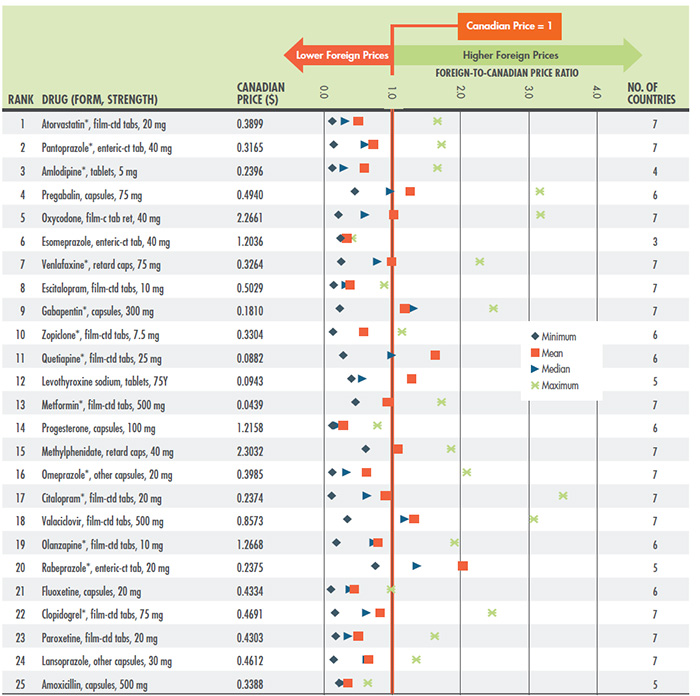
Figure description
This table gives multilateral comparisons of the foreign-to-Canadian price ratios for the 25 top-selling generic drugs in Canada in the fourth quarter of 2016. The Canadian generic price level is set to one; ratios greater than one indicate higher average foreign prices, while ratios less than one indicate lower foreign prices.
blank
| Rank |
Drug (form, strength) |
Canadian
price in dollars |
Minimum |
Mean |
Median |
Maximum |
Number of countries |
| 1 |
Atorvastatin*, film-coated tablets, 20 mg |
0.3899 |
0.12 |
0.50 |
0.31 |
1.66 |
7 |
| 2 |
Pantoprazole*, enteric-coated tablets, 40 mg |
0.3165 |
0.14 |
0.72 |
0.60 |
1.72 |
7 |
| 3 |
Amlodipine*, tablets, 5 mg |
0.2396 |
0.12 |
0.59 |
0.29 |
1.66 |
4 |
| 4 |
Pregabalin, capsules, 75 mg |
0.4940 |
0.45 |
1.26 |
0.97 |
3.16 |
6 |
| 5 |
Oxycodone, film-coated tablets retard, 40 mg |
2.2661 |
0.21 |
1.02 |
0.60 |
3.17 |
7 |
| 6 |
Esomeprazole, enteric-coated tablets, 40 mg |
1.2036 |
0.24 |
0.33 |
0.35 |
0.41 |
3 |
| 7 |
Venlafaxine*, retard capsules, 75 mg |
0.3264 |
0.25 |
0.99 |
0.78 |
2.28 |
7 |
| 8 |
Escitalopram, film-coated tablets, 10 mg |
0.5029 |
0.14 |
0.38 |
0.32 |
0.88 |
7 |
| 9 |
Gabapentin*, capsules, 300 mg |
0.1810 |
0.23 |
1.18 |
1.31 |
2.48 |
7 |
| 10 |
Zopiclone*, film-coated tablets, 7.5 mg |
0.3304 |
0.13 |
0.58 |
0.58 |
1.14 |
6 |
| 11 |
Quetiapine*, film-coated tablets, 25 mg |
0.0882 |
0.28 |
1.63 |
0.99 |
4.14 |
6 |
| 12 |
Levothyroxine sodium, tablets, 75Y |
0.0943 |
0.40 |
1.28 |
0.56 |
4.17 |
5 |
| 13 |
Metformin*, film-coated tablets, 500 mg |
0.0439 |
0.46 |
0.93 |
0.92 |
1.72 |
7 |
| 14 |
Progesterone, capsules, 100 mg |
1.2158 |
0.12 |
0.28 |
0.20 |
0.78 |
6 |
| 15 |
Methylphenidate, retard capsules, 40 mg |
2.3032 |
0.61 |
1.08 |
1.09 |
1.86 |
7 |
| 16 |
Omeprazole*, other capsules, 20 mg |
0.3985 |
0.12 |
0.62 |
0.33 |
2.09 |
7 |
| 17 |
Citalopram*, film-coated tablets, 20 mg |
0.2374 |
0.11 |
0.90 |
0.63 |
3.50 |
7 |
| 18 |
Valaciclovir, film-coated tablets, 500 mg |
0.8573 |
0.34 |
1.32 |
1.18 |
3.07 |
7 |
| 19 |
Olanzapine*, film-coated tablets, 10 mg |
1.2668 |
0.18 |
0.79 |
0.73 |
1.91 |
6 |
| 20 |
Rabeprazole*, enteric-coated tablets, 20 mg |
0.2375 |
0.75 |
2.03 |
1.36 |
4.79 |
5 |
| 21 |
Fluoxetine, capsules, 20 mg |
0.4334 |
0.10 |
0.44 |
0.38 |
0.98 |
6 |
| 22 |
Clopidogrel*, film-coated tablets, 75 mg |
0.4691 |
0.16 |
0.82 |
0.62 |
2.46 |
7 |
| 23 |
Paroxetine, film-coated tablets, 20 mg |
0.4303 |
0.17 |
0.50 |
0.35 |
1.62 |
7 |
| 24 |
Lansoprazole, other capsules, 30 mg |
0.4612 |
0.14 |
0.65 |
0.63 |
1.35 |
7 |
| 25 |
Amoxicillin, capsules, 500 mg |
0.3388 |
0.22 |
0.35 |
0.27 |
0.64 |
5 |
Note: Only the leading formulations for each molecule are represented. The list of 25 top-selling generic drugs reported reflects the ranking of drugs at the national level and includes public, private and out-of-pocket market segments.
For presentation purposes, the scale reporting the foreign-to-Canadian price ratio was limited to 4.0; observations higher than this value are not depicted here.
*Drugs under the 18% rule by Q4-2016:
- April 1, 2013: atorvastatin, ramipril, venlafaxine, amlodipine, omeprazole and rabeprazole.
- April 1, 2014: rosuvastatin, pantoprazole, citalopram, and simvastatin.
- April 1, 2015: clopidogrel, gabapentin, metformin, and olanzapine.
- April 1, 2016: donepezil HCl, ezetimibe, quetiapine, and zopiclone.
Source: QuintilesIMS MIDAS™ database, October–December 2016. All rights reserved.